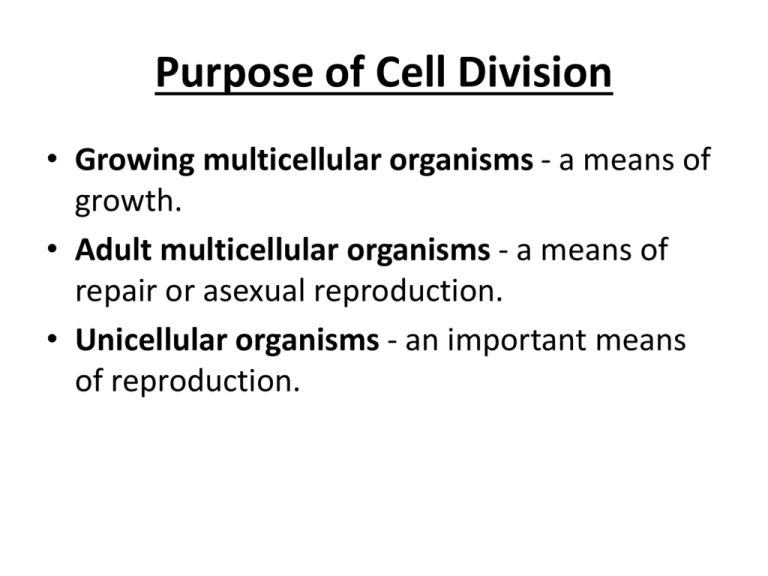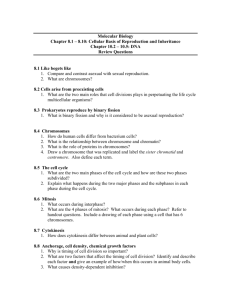Mitosis and Asexual Reproduction
advertisement

Purpose of Cell Division • Growing multicellular organisms - a means of growth. • Adult multicellular organisms - a means of repair or asexual reproduction. • Unicellular organisms - an important means of reproduction. Cells with a nucleus divide by Mitosis. Overview of Cell Division The Cell Cycle Phases of The Cell Cycle 1. Interphase • The cell carries out its work and duplicates its chromosomes. This includes the phases G1, S and G2 Phases of The Cell Cycle G1 - normal cell functions, and cell growth. - nuclear membrane is visible. - chromatin is uncoiled, and within the nucleus. Phases of The Cell Cycle S -DNA replication - The cell receives a signals to begin replication - DNA molecule unwinds. - DNA is replicated, by a group of enzymes. - Centrosome replicates DNA Replication • Each of the single strands of the original molecule serves as a template for the creation of a second DNA strand. • Free-floating DNA bases will bond, one base at a time, with bases on the original strand(A-T, G-C) Phases of The Cell Cycle G2 –cytoplasmic growth and preparation for cell division Mitosis – division of DNA Cytokinesis – division of cytoplasm Mitosis and Cytokinesis 1 Mitosis and Cytokinesis 2 Mitosis 1.Prophase Chromatin (DNA) coils into chromosomes which appear as rods. • Nuclear membrane disintegrates. • The 2 centrosomes start moving apart to opposite sides of the cell. • Microtubules form a mitotic spindle between the centrosomes. • Chromosomes start moving toward the equator of the cell. Chromatin becomes Chromosomes centromere Mitosis 2. Metaphase • Chromosomes line up at the equatorial plane of the spindle. • The 2 chromatids start to separate. Mitosis 3.Anaphase: Chromatids move toward opposite poles of the cell. Mitosis 4.Telophase (the reverse of prophase.) • Chromosomes uncoil. • New nuclear membrane is formed. Cytokinesis • cytoplasmic division. • Two new cells are created • The cells are in the G1 phase of the cell cycle Variations in Cell Division 1. Animal cell: • centrioles (2 in each centrosome) 2. Plant cell: • Formation of a cell plate, from small vesicles that had clustered at the equator • The cell plate grows to become a new cell wall. Plant Cell Cytokinesis • Asexual Reproduction in animals (generation of multiple individuals) Lower organisms only: (hydra, worms) • Regeneration in animals (replacement of part of an organism) Starfish, crabs, human liver Asexual reproduction of plants (vegetative propagation). • budding • runners (spider plant) • rhizomes (fern) • sprouts (potato) • hyacinth bulbs • cuttings




